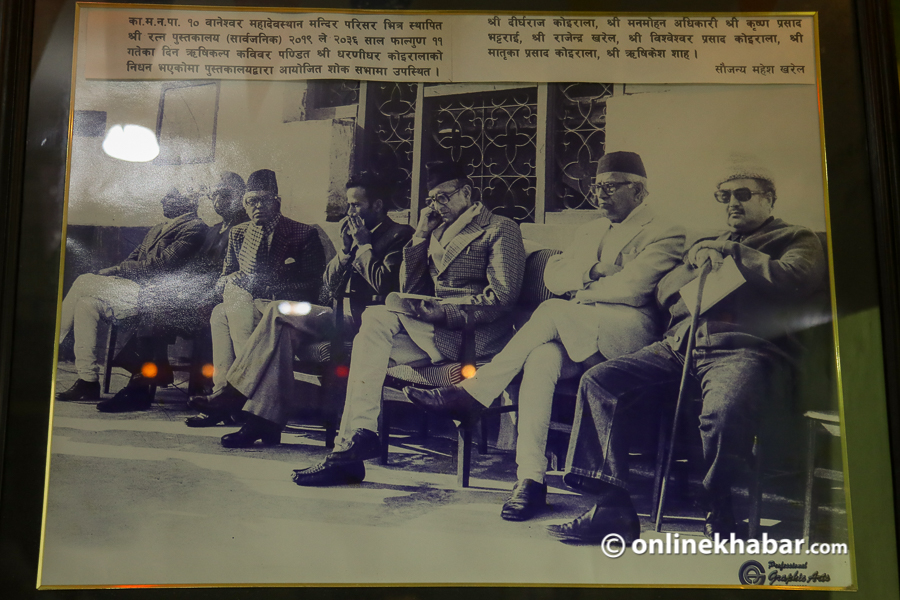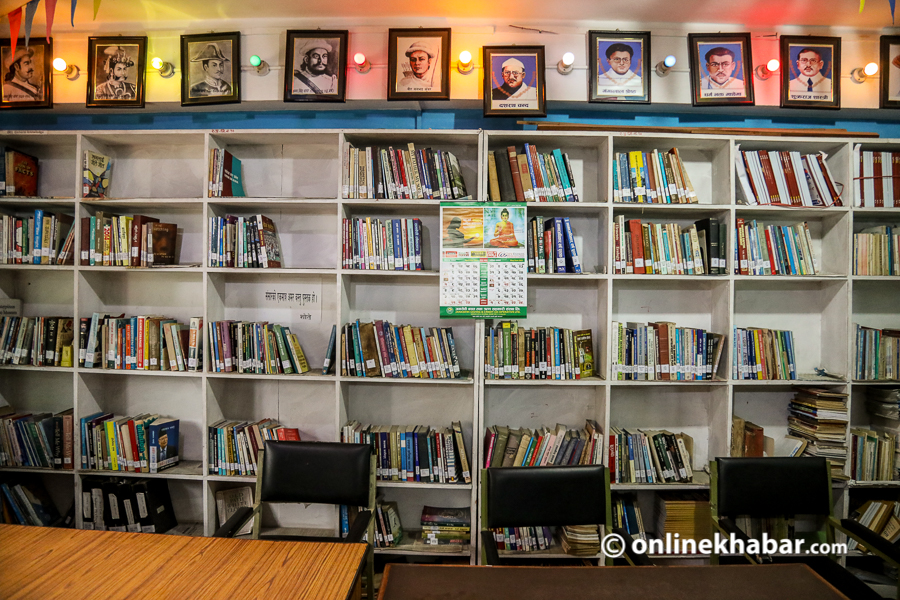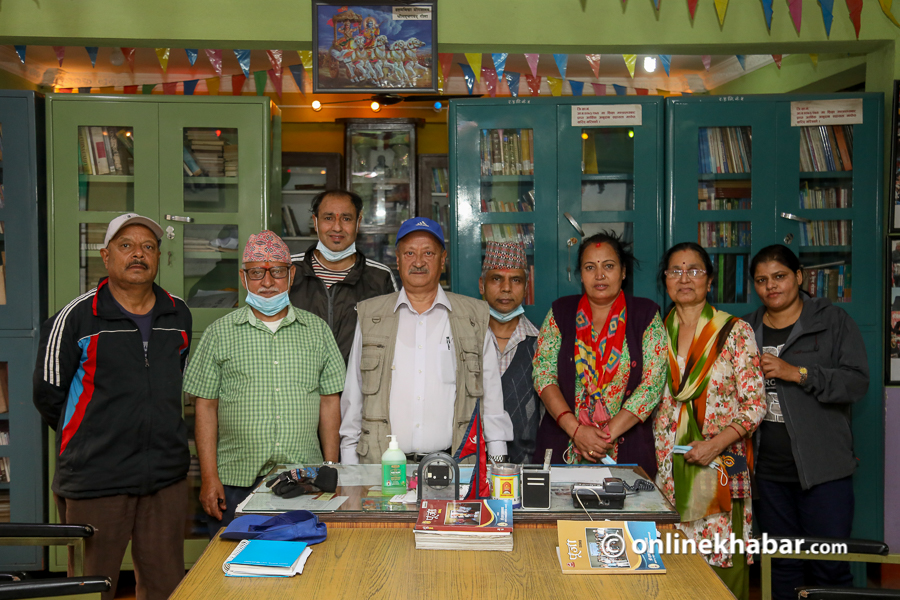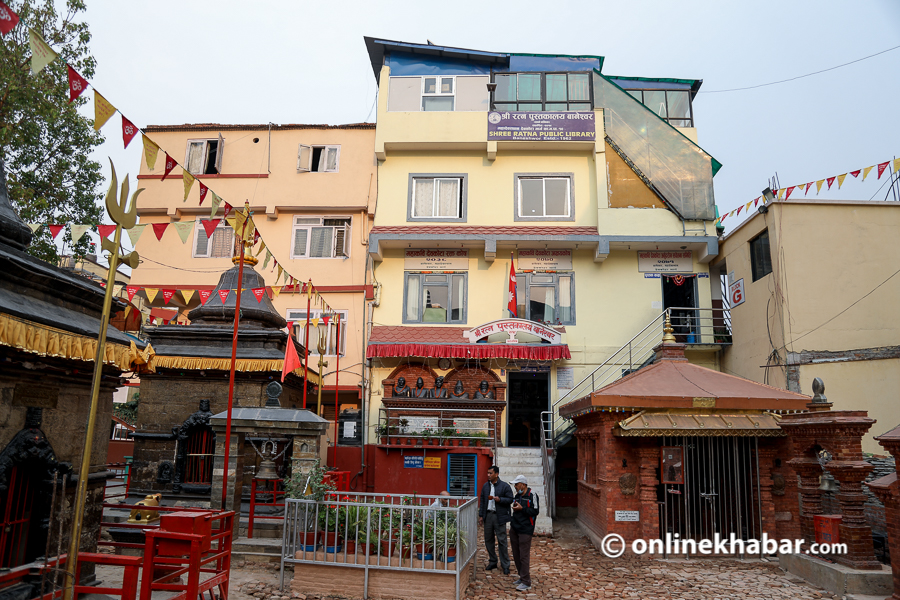Ratna Pustakalaya, located in Madhya Baneshwar of Kathmandu, is somewhere lost amidst adjoining houses, commercial malls, complexes, and shops. Yet, situated some 800 meters north of Naya Baneshwar Chok on Devkota Road, it has been in operation for six decades and it holds some historic significance.
This library is housed in the three-storey roadside building in front of the Mahadev temple and Ratna Rajya School. Yet, the general public does not know much about this library established in the early 1960s. Nonetheless, behind it has a glorious history of Nepali literature, society, and politics and a collection of more than 12,000 books.
Establishment
Today’s Baneshwar, located in the Kathmandu metropolitan city-10, was once a part of the Mahadevsthan Adarsha Gaun Panchayat as per the administrative division then.
Realising the need for a school in this village, Ratna Rajya Pathshala was established in 1960 in front of Baneshwar Mahadev temple. Later, the library was started mainly targeting the locals at that time.
However, it soon became a meeting place for the country’s top writers and social workers, says Shashi Bikram Rana, the current chairman of the library, who also has been associated with the library since 1967.
Historic significance

Describing the historic significance of the library, Rana shares, “There is still a picture of BP Koirala, Matrika Prasad Koirala, Man Mohan Adhikari, Rishikesh Shah, and Krishna Prasad Bhattarai present on the same platform for Dharanidhar Koirala’s condolence assembly. It reflects the unity and tolerance of Nepali society.”
Also, a picture of BP Koirala and King Mahendra together is hanging at the library. Rana says that the picture of these two personalities came together by chance.
On April 14, 2021, on the occasion of the Nepali New Year, the library unveiled a book with centenarian culture expert, Satya Mohan Joshi, as the chief guest. The 101-year-old then praised, “While working on literature, Ratna Pustakalaya is also serving the country and the culture.”
Rana says that not only Satya Mohan Joshi but all writers and culture experts in the capital come to the library at their convenience. Apart from this, the library has been conducting condolence assemblies for the departed writers.
This library has also received the honour of the best library given by the Ministry of Education on the occasion of National Library Day 2018.
Meeting point of great people

At present, at the library’s courtyard, there are busts of Laxmi Prasad Devkota, Parijat, Bhupi Sherchan, Pahalman Singh Swar, Dharani Dhar Koirala, and Chittadhar Hridaya.
Nepal’s first president, Ram Baran Yadav had unveiled these statues of these great authors of Nepali literature (excluding the statue of Laxmi Prasad Devkota).
Since its establishment in 1962, this public library has been organising numerous literary as well as cultural events and activities by inviting established writers, leaders, social activists, artists, educationists, and others. Also, many political programmes used to happen on the school premises, says Rana.
For instance, the then-banned party’s leader BP Koirala as a prolific writer of Nepali literature had reached its premises in 1980 to unveil the statue of Mahakavi Laxmi Prasad Devkota.
In the existence of the Panchayat system, BP Koirala became a villain in the eyes of the Panchayat system and its leaders. However, not only Koirala but all the top leaders and writers of the country have set foot in the Ratna Pustakalaya since its establishment.
“Similarly, literary programmes are also held on the occasion of Bhanu Jayanti and Devkota Jayanti, birth anniversaries of poets Bhanu Bhakta Acharya and Laxmi Prasad Devkota respectively, in the presence of famous writers of the country,” says Rana.
Mainly, in the library, there happen the gatherings of readers and book lovers. That is why the library has become a meeting point for great personalities. “This library was the starting point of political and social consciousness,” recalls Rana.
Writer Shekhar Kharel, who was born in Madhya Baneshwar, also remembers the literary and cultural programmes that used to be held in the library since his childhood. Kharel shares, “Hundreds of people attended the Laxmi Jayanti programme at Ratna library even if they are not invited. The main reason for this is the glorious history of this library.”
A model of well-managed institution

Unlike some of the mismanaged public libraries in the valley, this public library is managed pretty well. The library has been operating with the appropriate use of limited resources.
It is thanks to people like its joint secretary Shakuntala Joshi, who has worked as a librarian at Tribhuvan University for more than two decades, is spending her experience as a volunteer here.
“Even though it is small, we have tried to update the library according to time. Now, we are trying to digitalise all the books,” says Joshi.
At present, except for one salaried staffer, all others are working as volunteers in the operation of this library. According to Joshi, three rooms on the ground floor of the library building have been rented out to manage monthly expenses. In addition, donations, support from the ward office and other organisations are contributing to the expenses of the library.
Also on the ground floor of the library is a small hall for reading newspapers and magazines. The hall is open from 4 pm to 7 pm. In the evenings, locals come here and read newspapers.
Books related to literature and culture are kept on the upper two floors. Apart from this, there are pictures of legendary writers and politicians of Nepal.
Need for the participation of new generation

This library has more than 300 life members. However, it has seen a decline in the number of readers over the past few years. Prakash Acharya, the secretary of the library, says the number of readers coming to read newspapers is also decreasing over the years.
According to Acharya, the presence of the younger generation is low due to the lack of awareness about the library. That is why the available resources have not been utilised properly, he says.
In addition, Acharya says, “The trend of going to a library has disappeared as the new generation studies only digital contents. But, public libraries can also contain historical material that cannot be found by searching the internet.”
In order to encourage youth to visit the library, the institution has been holding an annual poetry competition for the youth, on the day of Laxmi Jayanti.
Likewise, Acharya stresses the need for proper publicity about the library to attract the younger generation while Rana says plans for doing so are underway.





















